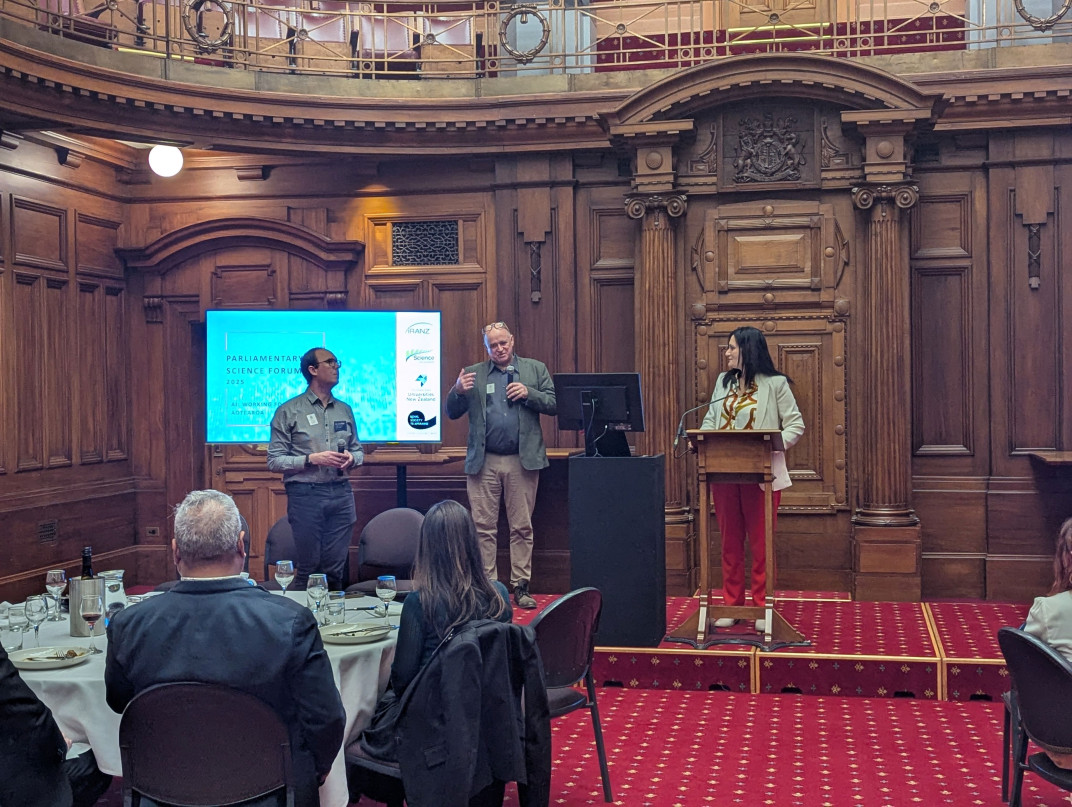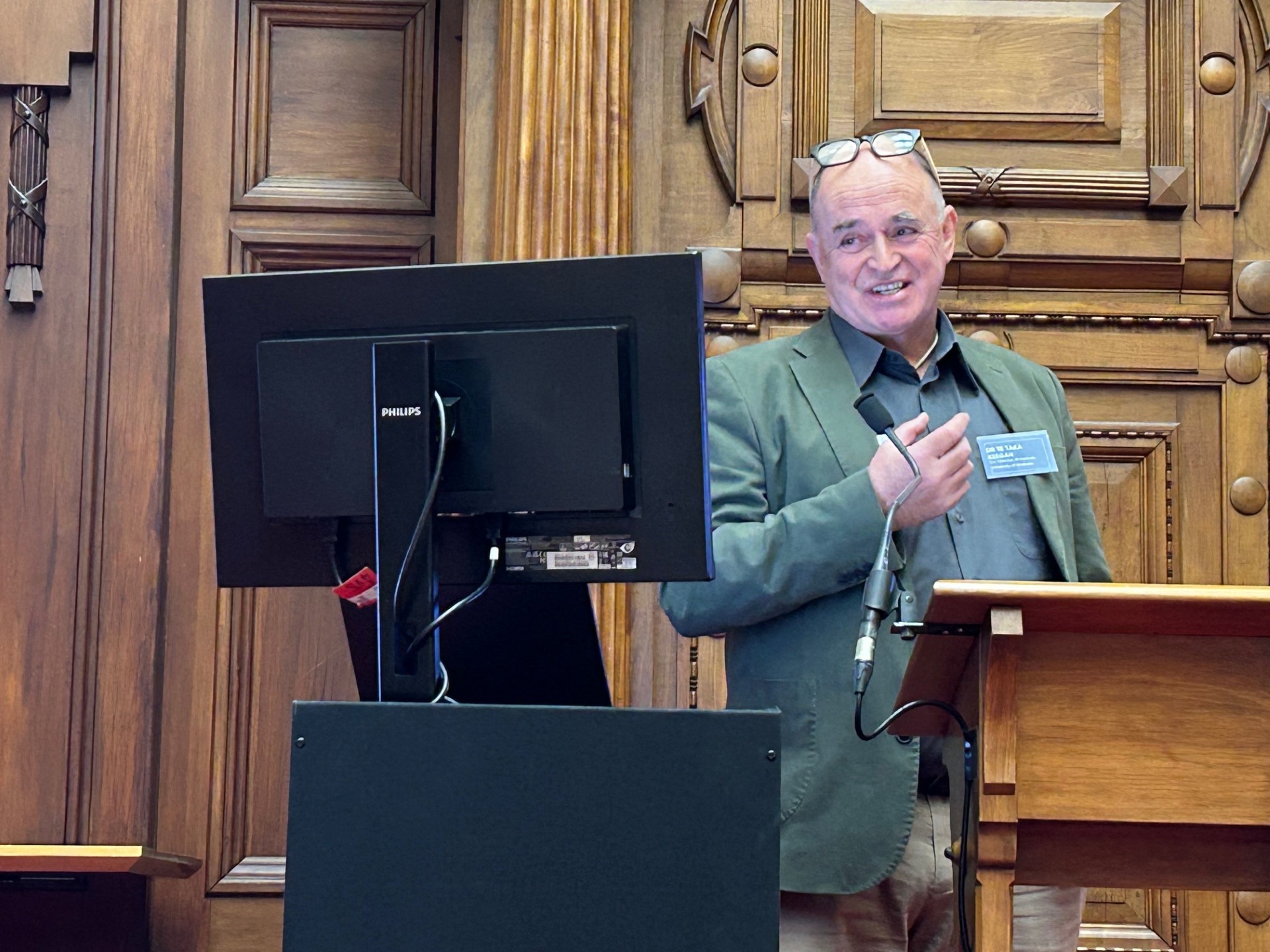AI at work in Aotearoa
The seventh event in 2025’s Parliamentary Science Forum was held on 12 Here-turi-kōkā August. Dr Jaco Fourie of Lincoln Agritech described AI as a tool to be used rather than a genuine intelligence. Associate Professor Te Taka Keegan gave MPs a sneak peek of a brand new te reo Māori-speaking AI.

Dr Te Taka Keegan (centre) answers questions with Dr Jaco Fourie and Dr Parmjeet Parmar MP.
AI is not intelligence, but it’s still a great tool
Dr Jaco Fourie, Machine Vision Principal Scientist, Lincoln Agritech
"The talk focused on my position regarding AI. While AI is "artificial," the "intelligence" part is often misunderstood. I argue that intelligence is not simply a tool that solves a problem or improves productivity; instead, intelligence is (among other things) the ability to select and correctly use the right tool. I demonstrate AI's utility as a tool and also highlight the dangers of treating it as true intelligence.
I then presented several high-profile negative case studies where AI was treated too much as an intelligence:
- IBM Watson Health: Despite an investment of over $1 billion and defeating Jeopardy! champions, IBM Watson Health failed to revolutionise healthcare or replace/assist human doctors. It was eventually sold off, costing IBM billions, primarily because it could not adapt or make decisions based on human common sense.
- Tesla Autopilot: Released in 2015 with estimated cumulative development costs between $2 billion and $10 billion, this advanced driver assistance system has been linked to hundreds of crashes and at least 51 fatalities as of October 2024. The failure stemmed from treating AI in optical object detection and scene understanding (and others), as sufficient for the complex, unpredictable conditions of real-world driving that require common sense human intelligence.
These failures, and others in various sectors, highlight common pitfalls when AI is misunderstood. I highlighted four main reasons for these failures:
- Unrealistic expectations: AI is trained for very specific tasks and cannot adapt to changing conditions unless explicitly re-trained. Its capabilities are limited by its training data.
- Poor data quality: Sophisticated models require vast amounts of data, and errors or gaps in this data directly lead to errors in AI output. AIs cannot self-regulate or self-correct.
- Unrecognised bias: Even good, accurate data can result in biased datasets by omitting important information, leading to skewed decisions or detections. Unlike humans, AIs cannot be introspective or adapt when bias is present.
- Inability to generalise to unlikely events: Rare or unusual events are often underrepresented in datasets, making AI unable to adapt to "border cases" and focusing too much on ordinary scenarios.
However, when used correctly as a tool, AI demonstrates incredible utility. I provided examples from my work at Lincoln Agritech:
- Forestry industry: AI is used to automatically identify and measure remaining bark on export logs after debarking. This helps maintain strict biosecurity standards, preventing costly rejections of shipments, while human operators still make critical decisions on log removal.
- Honey industry: To optimise Manuka honey production, AI analyses multispectral satellite imagery to detect the locations of Mānuka and similar Kānuka bushes based on their unique spectral signatures and flowering times. This tool assists beekeepers in positioning hives for maximum Mānuka pollen concentration in the honey.
- Horticulture and viticulture:
- Apple orchards: AI object detectors are combined with radar systems (which penetrate leaf canopies to sense fruit moisture) to provide faster and more accurate yield estimation and crop load management than manual methods. This is an example of AI used for sensor fusion.
- Grape vines: An AI algorithm was developed to learn pruning strategies from expert human pruners. This flexible system uses cameras and sensors to collect vine data and makes pruning decisions, with the ultimate goal of automating this laborious and expensive task with robotic pruning machines.
I also highlighted a new direction in AI: using it for research and scientific discoveries. I demonstrated how specialised AI models, called physics-informed neural networks, can take measurements of natural phenomena (e.g., chemical concentrations in a reaction) and generate complex mathematical models, such as sets of partial differential equations, that together describe these processes. This capability significantly accelerates scientific progress by allowing scientists to generate useful mathematical models much faster, potentially leading to new discoveries and technologies.
In conclusion, I reiterated that AI is an incredibly useful and flexible tool when employed correctly, but it is not an intelligence to be trusted to make independent decisions. While it offers immense potential for good, like any powerful technology, it also carries dangers if abused or misunderstood. The core message is that AI is "just maths" – a powerful mathematical tool to be used responsibly."

Dr Te Taka Keegan giving his live demonstration
AI and te reo Māori
Associate Professor Te Taka Keegan
Te Whare Wānanga o Waikato | University of Waikato
Te Kāhui Raraunga
Dr Te Taka Keegan (Waikato-Maniapoto, Ngāti Porou, Ngāti Whakaue) gave MPs a live demonstration of a new te reo Māori speech synthesizer that utilised generative reo Māori AI. It was developed in Aotearoa for Aotearoa. Dr Keegan asked it some questions such as 'He aha te kai o te rangatira' (what is the food of Chiefs?) and 'Ko wai ngā taniwha ki te Whanganui-ā-Tara' (what are the taniwha in Wellington Harbour?) and the AI responded in spoken reo, 'ko te kai a te rangatira, he kōrero...' (the food of chiefs is conversation) and 'E ai ki ngā kōrero, e rua ngā taniwha ko Ngake rāua ko Whātaitai... (it is said that there were two taniwha, Ngāke and Whātaitai).
MPs were treated to two different voices, one from Northland, built by Te Hiku Media and another new one that his team had built from Waikato-Maniapoto ( but not yet released to the public). Dr Keegan emphasised that AI voice, dialect, and mātauranga knowledge-base needed to be developed unique to each iwi and ceded under iwi protection.
International AI chatbots like ChatGPT can already speak te reo Māori, but Dr Keegan asserts that we should use resources developed and protected by Māori. He doesn’t think that we can stop people using AI to learn and engage with te reo Māori, but he is concerned that external AIs are trained on ‘stolen data’ and don’t necessarily get everything right. If a generation learns their reo from AI, there will be a shift in how we speak and think about Māori culture and a loss of local dialects that are integral to iwi identities.
Dr Keegan discussed concepts of Māori data sovereignty and governance of future Māori AIs by iwi. He acknowledged that views around AI and language vary but the most important thing is to protect te reo Māori and iwi knowledge as taonga.
